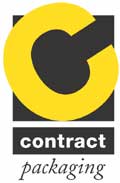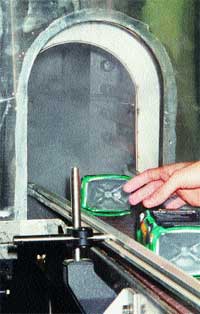January 29, 2014
Speeding onto consumer shelves this fall, a 32-oz Pennzoil-Quaker State motor-oil bottle shaped as a racecar appears in retail outlets. The heavily contoured bottle

features a high-impact, shrink-sleeve label that depicts Jeff Gordon's number 24 car from the Nascar Racing Series. Easy Contract Labeling, Dawsonville, GA, applies the full-body sleeves to the car-shaped bottle, utilizing its contract packaging expertise to meet this highly technical application.
Pennzoil launched this packaging initiative, but underestimated the technical complexities of the shrink sleeve and bottle at first, PD is informed. Clarence Jacobs, general manager of Easy Contract Labeling, says, "The challenge with the thin-walled, nonuniform bottle is the horizontal and vertical registration of the shrink-sleeve label onto the bottle."
With a nonuniform bottle shape, shrink sleeves need to endure rigorous shrinking and registration demands. SleeveCo provides the 2-mil, polyvinyl chloride (PVC) full-body shrink sleeves.
Martin Wilson, director of sales and marketing at SleeveCo, says, "The square-type bottle poses a few different obstacles. One is the distortion issue?during shrinking?and how that relates to the bottle's shape. The tire graphics on the shrink sleeve need to align with the bottle's ridges for the tires." Aquapac supplies the clear blow-molded, racecar bottles.
|
Top, finished, empty bottles await delivery to Pennzoil for filling. Above, rollers advance flat, shrink-sleeve film downward to a bullet-shaped forming device that forms the film into a tube. |
With the shrink-sleeve film, the main obstacle is the large amount of shrinkage in the neck area, PD is told. "The film is modified in the neck area, but we didn't want to lose the shrink properties that give uniform coverage for the rest of the bottle," adds Wilson. In order to alleviate the uniform coverage issue, SleeveCo uses a film with a grid design for registration.
Operation flexibility
Easy Contract Labeling has three shrink-sleeve lines, and machines are modified to meet varied contract labeling applications. The shrink-sleeve applicator for the Pennzoil bottle is modified extensively, and the shrink tunnel is also custom-manufactured, PD is told. Jacobs says, "We have flexibility in equipment and operations. Other contract packagers are dedicated to a certain size or bottle, but we have a whole range of equipment that we use for different shrinking applications."
For the Pennzoil bottle line, an Easy Contract Labeling custom-manufactured, shrink-sleeve applicator accepts upright PET bottles from a plastic belt conveyor and positions them in the application station. Eight feet above the application station, rollers advance flat, shrink-sleeve film downward to a bullet-shaped forming device. At this point, the forming mechanism forms the film into a tube so it can drape over the bottle waiting at the application station. As the label stock moves downward, rotating knives powered by a stepper motor cut each individual shrink sleeve. From there, a photoeye triggers high-speed wheels to transfer the sleeve from the machine to the bottle.
|
A shrink-sleeve bottle passes by an infrared heat lamp that shrinks the film onto the bottle's neck, but does not distort the bottle. |
For the Pennzoil production run, the newly sleeved bottles move to a collating table where sleeves are manually registered. Although, the applicating machine registers the sleeves, operators fine-tune them for the shrink tunnel. Wilson adds, "With this container, registration needs to be very accurate, and an extra inspection step is needed. The manual operation does add cost, but it does provide pinpoint accuracy."
At this point, operators place the sleeved bottles horizontally on a conveyor belt, and they travel quickly through a 6-ft.-long, 250 deg F steam tunnel. Easy Contract Labeling says the bottle is a thin-walled container, so it is run through as quickly as possible to avoid distortion. The bottle's sidewall is 0.01 in. thick.
|
The shrink-sleeved bottles exit the first shrink tunnel and move to a second tunnel, where hot air is applied to the neck area. |
The steam tunnel shrinks the sleeve onto the body and neck of the racecar bottle, and then a hot-air tunnel applies moderate heat to prevent the neck area from cooling. From there, infrared lamps make the final shrink to the neck area. The infrared heat lamps do not penetrate the bottles, just the film. The infrared lamps are specifically designed for this film, PD is told. The film's shrink range is 58 percent for this application.
Easy Contract Labeling spent two weeks evaluating how to get the best shrinkage, how the bottles should be positioned and how the sleeves are positioned. The finished bottles are shipped to Pennzoil for filling.
Easy Contract Labeling accomplished production of the first U.S. run of the bottles in three weeks. They didn't disclose the production rate for this application, but said there were no restrictions on the packaging line. The company says the equipment was never a restriction for production; it depended on the personnel numbers. With the success of the Jeff Gordon bottle, more Nascar motor-oil bottles are planned, PD is told.
Inherent in contract packaging is the ability to adapt to customers' demands. Easy Contract Labeling embraces this business stance wholeheartedly and says flexibility is their motto.
More information is available:
Contract packager: Easy Contract Labeling, 706/265-8193 Circle No. 252.
Labels: SleeveCo, Inc., 800/624-0204. Circle No. 253.
PET bottles: Aquapac, 905/672-9600. Circle No. 254.
About the Author(s)
You May Also Like





